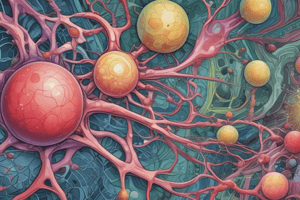Podcast
Questions and Answers
What is the primary function of the cell membrane?
What is the primary function of the cell membrane?
- To regulate what enters and leaves the cell (correct)
- To store genetic material
- To generate energy for the cell
- To synthesize proteins
What is the site of many cellular activities such as metabolism and protein synthesis?
What is the site of many cellular activities such as metabolism and protein synthesis?
- Mitochondria
- Endoplasmic Reticulum
- Cytoplasm (correct)
- Nucleus
What is the control center of the cell?
What is the control center of the cell?
- Golgi Apparatus
- Mitochondria
- Endoplasmic Reticulum
- Nucleus (correct)
What type of cells lack a true nucleus?
What type of cells lack a true nucleus?
What is the process by which cells generate energy from glucose?
What is the process by which cells generate energy from glucose?
What is the byproduct of Aerobic Respiration?
What is the byproduct of Aerobic Respiration?
What type of respiration does not require oxygen?
What type of respiration does not require oxygen?
Flashcards are hidden until you start studying
Study Notes
Cell Structure
- Cell Membrane (Plasma Membrane):
- Semi-permeable membrane that separates the cell from its environment
- Regulates what enters and leaves the cell
- Cytoplasm:
- Jelly-like substance inside the cell membrane
- Site of many cellular activities (metabolism, protein synthesis)
- Nucleus:
- Control center of the cell
- Contains DNA (genetic material)
- Organelles:
- Mitochondria: generate energy for the cell
- Endoplasmic Reticulum (ER): protein synthesis and transport
- Ribosomes: protein synthesis
- Lysosomes: cell digestion and recycling
- Golgi Apparatus: protein modification and transport
Cell Types
- Prokaryotic Cells:
- Lack true nucleus
- Typically small, simple cells (bacteria)
- Eukaryotic Cells:
- Have true nucleus
- Typically larger, more complex cells (plants, animals, fungi)
6th Grade Cell Respiration
- Cellular Respiration:
- Process by which cells generate energy from glucose
- Occurs in mitochondria
- Aerobic Respiration:
- Requires oxygen (O2)
- Produces energy (ATP) and water (H2O) as byproducts
- Anaerobic Respiration:
- Does not require oxygen (O2)
- Produces energy (ATP) and lactic acid as byproducts
Cell Structure
- Cell membrane is semi-permeable, regulating what enters and leaves the cell.
- Cytoplasm is a jelly-like substance inside the cell membrane, where many cellular activities occur.
- The nucleus is the control center of the cell, containing DNA (genetic material).
- Mitochondria generate energy for the cell through cellular respiration.
- Endoplasmic Reticulum (ER) is responsible for protein synthesis and transport.
- Ribosomes are responsible for protein synthesis.
- Lysosomes facilitate cell digestion and recycling.
- Golgi Apparatus modifies and transports proteins.
Cell Types
- Prokaryotic cells lack a true nucleus and are typically small and simple (bacteria).
- Eukaryotic cells have a true nucleus and are typically larger and more complex (plants, animals, fungi).
Cell Respiration
- Cellular respiration generates energy from glucose and occurs in mitochondria.
- Aerobic respiration requires oxygen (O2) and produces energy (ATP) and water (H2O) as byproducts.
- Anaerobic respiration does not require oxygen (O2) and produces energy (ATP) and lactic acid as byproducts.
Studying That Suits You
Use AI to generate personalized quizzes and flashcards to suit your learning preferences.




